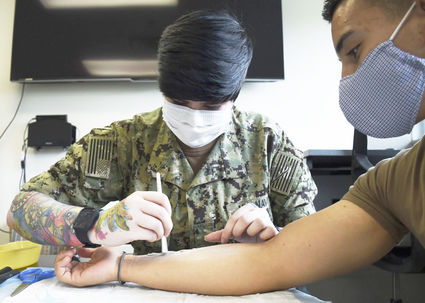Artistic Effort and Special Effects Enhance Medical Training
October 14, 2020
Latex paint and an assortment of makeup and brushes filled the end of a large table in a breakroom at Navy Medicine Readiness Training Unit (NMRTU) Everett. The room usually functions as a location for the occasional meeting, training exercise, or a place for staff members to dine during the day.
Instead of lunching at the table, Hospitalman Tonii Farmer, assigned to NMRTU Everett, is using the breakroom as a space to share her creative ability in the decidedly untraditional art form of moulage.
Moulage – a French term - is the skillful ability of fashioning mock injuries with lifelike material such as makeup to train emergency response teams and other medical and military personnel.
Farmer, from Chinook, Mont., graduated from Chinook High School in 2015, and joined the Navy as a hospital corpsman in 2018.
"I knew I wanted to do something in medical and it was a great chance to also serve," said Farmer. "My dad was in the Navy and he always talked about how he loved it so much. It just kind of seemed like the right fit."
Farmer, insisting she always had an affinity for art and enjoyed dabbling in painting and creative expressions, started using moulage as a way to better understand certain wounds and how to treat them in a more hands-on manner.
"I always wished they would have done training like this for me when I was a brand new corpsman, because I'm very hands-on," explained Farmer. "We were going over a [personnel qualification standard] and what training we need, and there was a laceration. I thought, well I can actually make a laceration so we can actually do that training rather than just talk about it."
Since initiating the training in June of 2020, Farmer has been able to hold several training courses implementing moulage into the routine for Sailors at NMRTU Everett.
"Farmer has been very instrumental in my journey here at Everett," said Hospitalman Ernesto Maysonet, (also) assigned the NMRTU Everett. "When she came up with this idea, it was kind of funny at first, because she didn't tell anyone about it. It was a big surprise, and I'm definitely very thankful for it because we don't really get to train hands-on until situations happen in real life. It is very beneficial to use the moulage to work through the situation before you have to work with someone that is actually in pain."
Although the Sailors that Farmer works with did not know about her plan to use moulage as a training aid, she did take her idea to her supervisor.
"This is the first time I've had a corpsman say, 'Hey, let me try to create something more realistic,'" said Renata Lukezic a pediatrician in family medicine at NMRTU Everett.
Lukezic is one of the medical providers that oversees Farmer. She explained that this type of hands-on training allows Sailors to practice in a less demanding environment.
"Medical education is definitely moving towards more simulation," said Lukezic. "There are schools that do almost all their anatomy classes through simulation. It's a great way to learn because you can practice over and over. I think it's a really important opportunity to practice in an environment that's stress-free."
Farmer expressed that this training promotes mission readiness and is optimistic about it helping prepare new corpsmen to respond effectively when sent to the field.
"I hope it helps the junior corpsmen know what to do in a difficult situation, and allow them to be calm and ready for certain situations," said Farmer. "Hopefully they think back on this training and are able to act rather than think, 'What do I do now?'"








